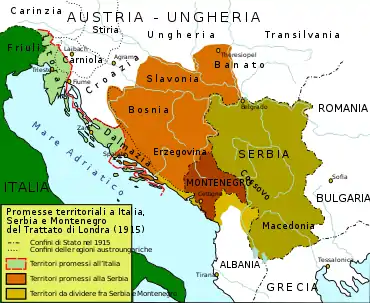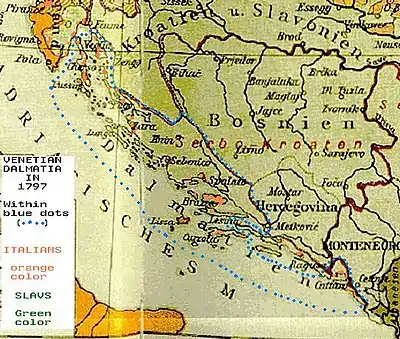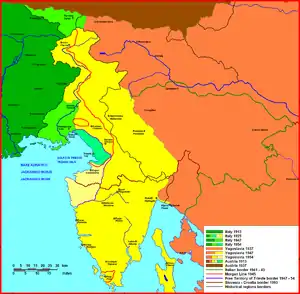Mutilated victory
Mutilated victory (Italian: vittoria mutilata) was a term used by Italian nationalists and Italian irredendists to describe their dissatisfaction concerning territorial rewards in favor of Italy at the end of World War I. The rhetoric of vittoria mutilata was adopted by Benito Mussolini and led to the rise of Italian fascism, becoming a key point in the propaganda of Fascist Italy. Historians regard vittoria mutilata as a "political myth", used by fascists to fuel Italian imperialism and obscure the successes of liberal Italy in the aftermath of World War I.[1]

Description

Italy joined World War I in 1915 on the side of the Allies, after negotiating the secret Treaty of London with the Triple Entente (Britain, France, and Russia). According to the secret pacts of London, the following territories were promised to Italy in case of victory: Trent and South Tyrol, the Austrian Littoral (Trieste, Gorizia and Gradisca, and Istria), territories in Dalmatia, a protectorate over Albania with direct control of Vlora, and compensations in case of a colonial partition of the Central Powers' empires. The content of the pact of London was made public in 1917 by the Russians, following their withdrawal from the War after the communist revolution, in order to criticize the "old diplomacy" of the capitalist European powers. While France and Britain remained bound by the treaty of London, the US president Woodrow Wilson (who joined the Allies in 1917) opposed it and presented on January 8, 1918 fourteen points to redraw the map of Europe on the basis of nationality and ethnicity. During the decisive Italian offensive, the nationalist poet Gabriele D'Annunzio coined the term mutilated victory by publishing an article in the Corriere della Sera dated October 24, 1918 and titled "Our victory will not be mutilated".[2]
Italy's prime minister Vittorio Orlando, one of the Big Four of World War I, and his foreign minister Sidney Sonnino, an Anglican of British origins, arrived at the Paris Peace Conference, 1919 in order to secure most of the London pacts. Considerable results were achieved with the treaties and agreements signed in 1919 and 1920. Most importantly, Trent-South Tyrol and the Austrian Littoral (Trieste, Gorizia and Gradisca, and Istria) became part of the Italian regions of Trentino-Alto Adige and Friuli-Venezia Giulia. The colonial compensations obtained by Italy were: the recognition and enlargement of the Italian Islands of the Aegean; a transfer of the Aozou strip and Jubaland to Italian Libya and Italian Somalia respectively; a claim on the Austrian concession of Tientsin; and the establishment of an Italian sphere of influence over the Ottoman area of Antalya, later abandoned with the independence of Turkey. Italy also received the province of Zadar with some islands in Dalmatia and set up an Italian protectorate over Albania with the occupation of Vlora, which lasted until 1920 when domestic opposition within the Italian Armed Forces and the Vlora war led Italy to voluntarily abandon Albania (with the exception of some islands) and the talks with the Allies concerning the issue. Finally, the disintegration of its two main rival powers (Austria-Hungary in Europe and the Ottoman Empire in the Mediterranean) and the entrance in the League of Nations' security council as a permanent member, cemented Italy's status as a great power.

Therefore, most of the nationalist criticism directed against the Allies and liberal diplomats focused on Dalmatia and the city of Fiume (which was later occupied by Italian nationalist Gabriele D'Annunzio). A more substantial transfer of Dalmatian territories to Italy (favored by Sonnino) was complicated to achieve because of its Slavic population, whereas Fiume was ethnically an Italian city (and as such proposed by Orlando as an alternative) but not included in the Pact of London. Wilson vetoed these proposals on the ground that already many German speakers and Slavs were under Italian rule. This led Orlando and Sonnino to temporarily abandon the conference in protest. Orlando had refused to see WW1 as a mutilated victory and once replied to nationalists calling for greater expansion that "Italy today is a great state....on par with the great historic and contemporary states. This is, for me, our main and principal expansion." But the nationalist climate ultimately forced Orlando to resign, and the Treaties he negotiated were signed by his successors Francesco Saverio Nitti and Giovanni Giolitti.[3]
Much of Mussolini's foreign policy was presented as an attempt to amend the perceived injustices of the mutilated victory: Fiume was taken over in 1924; Albania was turned into an Italian puppet state under Zog I of Albania and merged into Italy in 1939; the annexation of all of Dalmatia during the Axis occupation of Yugoslavia prolonged Italy's participation in World War II. Contemporary historians see the alleged correction of the mutilated victory as a part of the larger Mussolini's imperialist project that brought Italy to intervene in Spain, conquer Ethiopia, and occupy south-west France, Tunisia, and Corsica, by entering WW2. As the historian Gaetano Salvemini put it: Fascism originated, grew, triumphed, and ultimately died, on the myth of vittoria mutilata.[4]
Italy and the Triple Alliance
Angered by the French seizure of Tunisia, in which Italy had extensive economic interests and had viewed as a possible area for colonial annexation, in 1882, Italy joined the Triple Alliance with Germany and Austria as a means of defending against further French aggression and gaining diplomatic backing for coming disputes.[5] The alliance, however, proved troublesome. Italy and Austria-Hungary had been rivals for many years; the latter had, for years, held northeastern Italy, opposed Italian unification, and it still held Trieste and Istria, Zara and the coast of Dalmatia, the primary targets of the Italian irredentist movement.
As such, in the years before 1914, Italy engaged in diplomatic maneuvers to ally itself with the United Kingdom and France. In 1902, Italy concluded a secret treaty with Britain in which Italy abandoned the Triple Alliance, with the stipulation that it be given the territories currently controlled by Austria.
The Treaty of London (1915)
After World War I erupted, the pressure by both sides for Italy to enter the war increased. On April 26, 1915, the Triple Entente and Italy signed a secret agreement, called the Treaty of London, that stipulated the terms of Italy’s participation in World War I against the Germany-Austrian Alliance. If Italy declared war on Germany and the Entente emerged victorious, Italy would be awarded territories of the House of Habsburg in the Southern Alps and in the Balkans, specifically the regions of Trentino and the South Tyrol (up to the northern limit of the Brenner Pass), the Friuli-Julian area, Trieste and the surrounding area, Istria, and the North of the Dalmatian Cost including the city of Šibenik. Other possible territories included in the treaty were the city of Vlorë in Albania, some part on the south Anatolian coast, as well as a share of the German colonial empire.

These demands were outlined by the Italian Foreign Minister Sidney Sonnino to secure a strong Italian presence in the Mediterranean. The acquisition of the area surrounding the Adriatic, especially the port city of Trieste, would strengthen Italian naval presence and keep pace with possible postwar territorial gains in the area by the other members of the Entente. The demands for lands carved from the Ottoman Empire and the African colonies were motivated by national ambition.
Sonnino however delayed a declaration of war against Germany even though Italy had declared war on Austria-Hungary. By May 1915, the Italian push towards Ljubljana reached a stalemate with Austrian forces in the Alps while Britain, France and Germany were embroiled in a stalemate of their own on the Western Front. The outcome of the war was not yet clear, and Sonnino stood by a position of neutrality with Germany. That would soften as Sonnino realized Italy’s army was in no position to carry out a protracted war, and pressure from within Italy demanded solidarity with the Entente. The Italian government declared war on Germany on 28 August 1916.
Wilson's opposition
In January 1917, British Foreign Secretary Arthur Balfour wrote a letter to American President Woodrow Wilson expressing his disapproval of the promise to give Italy the Adriatic territories. In a later trip to the United States in May to speak with American diplomat Edward M. House about the pact, Balfour made it clear that Britain had no particular ill will against Austria-Hungary and that the planned transfer of the Slavic lands to Italy would only create more problems. While American-Italian diplomatic dialogue regarding the claims did not take place prior to the Peace Conference, Wilson’s own stance on the matter was clear in his Fourteen Points, which urged for the Italian border with Austria to be redrawn along "clearly recognizable lines of nationality". His first point urged for no international agreements to be negotiated in secret so he refused to recognise the arrangements made under the pact. Sonnino's plans for securing the Adriatic were ignored, as were the imperial aims of Italy, and concessions were made in the form of postwar American economic aid.[6]
Aftermath
The cause of Mutilated Victory was embraced by many Italians on the political right. The poet Gabriele D'Annunzio criticized in print and in speeches the failures of Prime Minister Vittorio Emanuele Orlando at the proceedings in Versailles, particularly in his attempts to acquire the city of Fiume (now Rijeka), which notwithstanding the fact that its inhabitants were at more than 90% ethnic Italians, was supposed to be ceded by Austria to the Kingdom of Serbs, Croats, and Slovenes. On September 12, 1919, D’Annunzio took matters into his own hands and led 2600 Italian irredentist troops against a mixed force of Allied soldiers to occupy the city. In Fiume, the victors established the Italian Regency of Carnaro, an unrecognized state based on the protofascist Charter of Carnaro.
While the regime would be short-lived, its effect on the people and politics of Italy would leave their mark on the following decades of Italian history. Benito Mussolini embraced the ideals of the D'Annunzio and Carnaro when he formed the first Fascio di Combattimento, an association devoted to violence, imperialism, and the repression of the Italian Socialist Party (PSI). Mussolini, an avid supporter of the First World War, credited the over 1.2 million military and civilian casualties and 148 billion lire spent[7] to both the weaknesses of the Liberal government and the treacheries of Italy’s former allies.
After his rise to power in 1922, Mussolini would continue to cite the mutilated victory in Fascist rhetoric.
See also
References
Notes
- G.Sabbatucci, La vittoria mutilata, in AA.VV., Miti e storia dell'Italia unita, Il Mulino, Bologna 1999, pp.101-106
- Cfr. Gabriele D'Annunzio, in an editorial in Corriere della Sera, October 24, 1918, Vittoria nostra, non sarai mutilata ("Our victory will not be mutilated")
- da Atti Parlamentari, Camera dei Deputati, Discussioni
- "...il movimento fascista sorse, crebbe, trionfò, e alla fine si stroncò, sul mito della "vittoria mutilata"...", G. Salvemini, Scritti sul Fascismo, vol. 3, Feltrinelli, 1974, p. 417
- Lowe, C.J. (2002). Italian Foreign Policy 1870-1940. Routledge.
- Burgwyn, H. James. (1993). The Legend of the Mutilated Victory. Greenwood Press.
- Mack Smith, Denis (1997). Modern Italy. The University of Michigan Press.
Bibliography
- Burgwyn, H. James. The Legend of the Mutilated Victory (Greenwood Press, 1993).
- Lowe, C.J. Italian Foreign Policy 1870-1940 (2002).
- Mack Smith, Denis. Modern Italy . (University of Michigan Press, 1997)
- Wilcox, Vanda. "From heroic defeat to mutilated victory: The myth of Caporetto in Fascist Italy." in Jenny Macleod, ed. Defeat and Memory (Palgrave Macmillan, 2008) pp. 46-61.